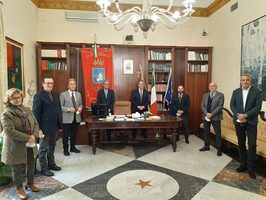
Itinerari
STORIA E TRADIZIONI.
Storia e tradizioni -
History and traditions.
Un rincorrersi tra mare e terra
la storia di Marsala. Sorge su Capo Boeo, la parte più occidentale della
Sicilia, in un territorio che, tra stradine del centro storico e borgate dell'entroterra,
coltiva la tipica ospitalità mediterranea. Prima Lilibeo, la splendidissima
civitas, poi Marsa Alì, da cui l'attuale nome. Marinara e vinicola, città di
fiori, fragole e ceramica, da qui Garibaldi e i suoi Mille avviarono il
Risorgimento italiano cui è dedicato il
Museo Civico. Giallotufo, azzurromare, rossotramonto, biancosale, verdevigneto
sono i colori che accompagnano il viaggiatore in questa terra dalle origini
fenicie e con influenze greche, romane, arabe, normanne, sveve, angioine, spagnole,
inglesi.
Un'esplosione di emozioni, tra
storia, fede e tradizioni, che si rivive nelle Processioni della Settimana
Santa, nelle Celebrazioni Garibaldine e nella Festa di San Giovanni. Ma anche
negli antichi mestieri: la lavorazione di botti e palma nana, sale e ceramica.
The
history of Marsala
is interwoven with sea and land. Marsala stands on Capo Boeo,
the western tip of the mainland Sicily. First Lylibaeum, splendidissima civitas,
then Marsa-Alì under the Arabs and finally Marsala. Garibaldi started the Italian Risorgimento
in this city of flowers,
strawberries and pottery. (The civic museum
is named after him). Tufa-yellow, sea-blue, sunset- red,
salt-white, vineyard-green are the colours that
accompany the tourist in
this land with Phoenician origins, with Greek, Roman, Arab, Norman, Swabian,
Angioine, Spanish and English influences.
There is an explosion of the emotions among
history, faith and tradition
which can be seen in the Easter
week processions, the Garibaldi celebrations
and St. John's feast
day; not only these but also in
traditional crafts, such as wine- barrel making, weaving dwarf palm
leaves, salt harvesting and pottery.
